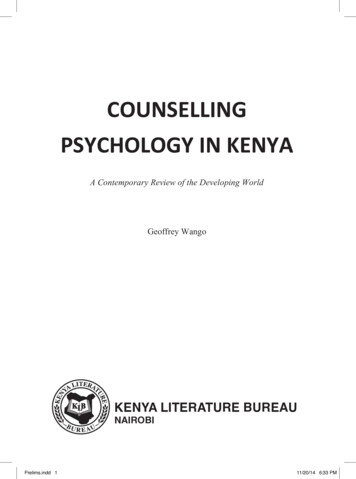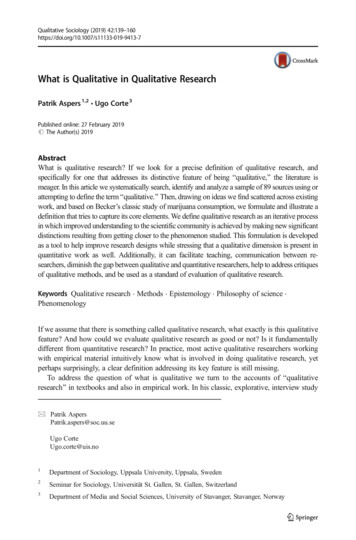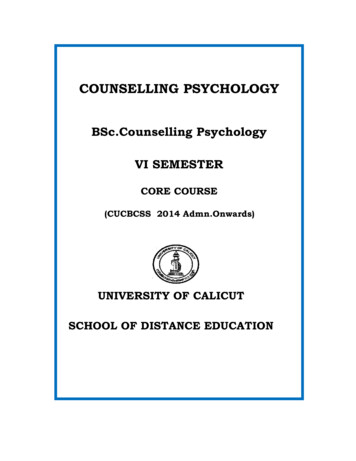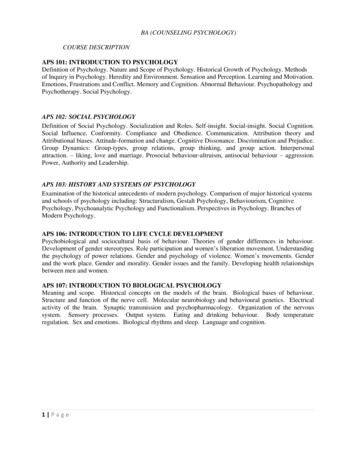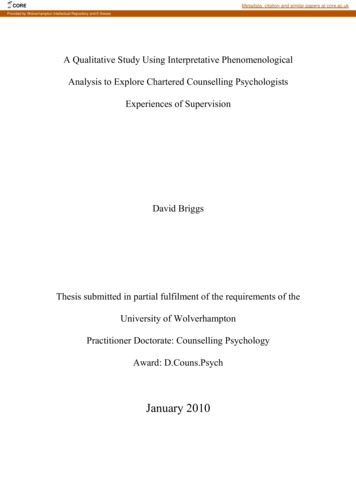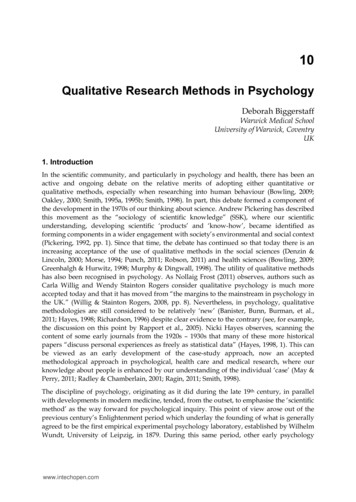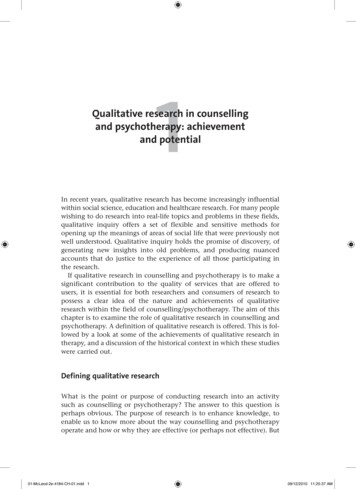
Transcription
1Qualitative research in counsellingand psychotherapy: achievementand potentialIn recent years, qualitative research has become increasingly influentialwithin social science, education and healthcare research. For many peoplewishing to do research into real-life topics and problems in these fields,qualitative inquiry offers a set of flexible and sensitive methods foropening up the meanings of areas of social life that were previously notwell understood. Qualitative inquiry holds the promise of discovery, ofgenerating new insights into old problems, and producing nuancedaccounts that do justice to the experience of all those participating inthe research.If qualitative research in counselling and psychotherapy is to make asignificant contribution to the quality of services that are offered tousers, it is essential for both researchers and consumers of research topossess a clear idea of the nature and achievements of qualitativeresearch within the field of counselling/psychotherapy. The aim of thischapter is to examine the role of qualitative research in counselling andpsychotherapy. A definition of qualitative research is offered. This is followed by a look at some of the achievements of qualitative research intherapy, and a discussion of the historical context in which these studieswere carried out.Defining qualitative researchWhat is the point or purpose of conducting research into an activitysuch as counselling or psychotherapy? The answer to this question isperhaps obvious. The purpose of research is to enhance knowledge, toenable us to know more about the way counselling and psychotherapyoperate and how or why they are effective (or perhaps not effective). But01-McLeod-2e-4184-CH-01.indd 109/12/2010 11:25:37 AM
2Qualitative Research in Counselling and Psychotherapythere are deeper questions that lie behind this type of common-senseperspective on the role of research. What do we mean by ‘knowing’ and‘knowledge’? It is possible to identify two broad styles of knowing thatexist within Western culture and society. The psychologist JeromeBruner (1986, 1990, 2002) has described these distinct ways of knowingas ‘paradigmatic’ and ‘narrative’. Paradigmatic knowing is associatedwith positivist physical sciences and involves the establishment ofabstract ‘if–then’ statements about the world, which seek to explain howobservable phenomena are the result of specific causal factors and processes. By contrast, narrative knowing is associated with everydayaccounts of human action, usually in the form of stories. We make senseof the events of our lives by telling stories to ourselves, and others, aboutwhat happened, when it happened, what each person said and did, andso on. Paradigmatic knowledge reflects an ‘objective’ deterministicworld; narrative knowing reflects a ‘constructed’ world in which humanagency can make things happen.Exercise 1.1 Reflecting on forms of knowingTake a few minutes to think about your work as a counsellor or psychotherapist.How do you know what to do in response to your clients? What are the sourcesof your knowledge? How adequate is the narrative–paradigmatic distinction asa means of classifying the types of knowledge that you use? What othercategories come to mind, in relation to knowledge sources that are meaningfulfor you?Within the academic and professional community, there has beenconsiderable tension between these alternative ways of knowing.Paradigmatic knowledge has accrued status and influence through itsuse within medicine, the physical sciences and technology. Narrativeknowing, by contrast, represents the domain of ‘softer’ (and economically less powerful) disciplines such as literature, art, anthropology andhistory. There have been many individuals and groups who have arguedfor the incommensurability of these approaches to knowledge. However,it is also possible to adopt a more pluralistic or pragmatic position (theperspective adopted in this book), which views both paradigmatic andnarrative forms of knowing as essential human accomplishments thatcan be combined in many ways in order to serve different purposes.Within everyday life, and therapy practice, we routinely tack back andforward between narrative and paradigmatic ways of making sense ofproblems. For instance, if someone comes into therapy because they arestruggling to come to terms with the effects of a serious car accident,then both therapist and client are comfortable with talking about the01-McLeod-2e-4184-CH-01.indd 209/12/2010 11:25:37 AM
Qualitative Research: Achievement and Potential3causal, determinist aspects of what has happened (the ice on the road,the speed at which the other person was driving, the effect of the drugstaken to alleviate pain) as well as the personally and collectively constructed meaning of the event (e.g., the significance of losing one’s job).Similarly, the research literature as a whole necessarily encompassesexamples of both narrative and paradigmatic ways of making sense ofspecific issues and phenomena. And within any individual research article, there is usually a story or stories that are being told, alongside somekind of more generalized or abstract model that is being proposed.Where does qualitative research fit into these types of knowing? Thestarting point for qualitative research is conversations and stories, andinterpretation of objects, images and rituals that tell stories or are meaningful in some way. Qualitative research is therefore firmly rooted in the‘narrative’ side of Bruner’s narrative–paradigmatic distinction. However,qualitative methods can readily be used, as reflected by many examplesin the chapters that follow, to generate or test abstract ‘paradigmatic’cause–effect models. Qualitative research starts with language and meaning, and can reach out into the domain of numbers and ‘variables’.Quantitative research starts with numbers and causal linkages betweenvariables and can reach out into the domain of stories. Mixed methodsresearch seeks to harness both forms of knowing at the same time. Thekey point here, and the underlying philosophy of this book, is that forpractical purposes, qualitative/narrative and quantitative/paradigmaticforms of knowing complement each other. They are both necessary. Thisis particularly important within the field of research into counsellingand psychotherapy. A knowledge or evidence base for therapy that consisted only of qualitative findings, or only quantitative findings, wouldbe like thinking with one hemisphere of the brain anesthetised – it canbe done, sort of, but it is not very effective.There are many definitions of qualitative research that can be foundin textbooks and in the writings of leading figures in this field. I wouldlike to offer my own definition, that I believe is particularly attuned tothe needs and interests of therapy researchers and practitioners. In myview, qualitative methods contribute a particular kind of knowledgeabout the world, which can be summed up in these terms: the primaryaim of qualitative research is to develop an understanding of how the socialworld is constructed. The notion of the world being ‘constructed’ impliesthat we inhabit a social, personal and relational world that is complex,layered and can be viewed from different perspectives. All of this is theresult of human activity. We construct our world through many forms ofindividual and collective action: talk and language (stories, conversations), systems of meaning, memory, rituals and institutions, and all themyriad ways in which the world is physically and materially shaped byhuman purposes. The various qualitative methodologies that have been01-McLeod-2e-4184-CH-01.indd 309/12/2010 11:25:37 AM
4Qualitative Research in Counselling and Psychotherapydevised, and that are introduced in later chapters, all seek to contributeto an understanding of how the world is constructed, but each of themtakes on a different facet of this task. For example, some qualitativeresearch focuses on the meanings through which people construct theirrealities. Other researchers concentrate on the way that shared culturalworlds are constructed through ritual, myth and social practices such askinship rules. Still other researchers seek to make sense of how reality isconstructed through talk and language use. Finally, there are qualitativeresearchers who are interested in challenging existing structures ofunderstanding (de-constructing) or in building new ways of doing things(re-constructing).This is why qualitative research is so useful for therapy. It is certainlyimportant to have access to paradigmatic cause-and-effect knowledge,such as the finding that cognitive-behavioural therapy (CBT) is moreeffective than other forms of therapy with clients experiencing panicdisorder. But that CBT intervention consists of therapists and clientswho each act as purposeful, intentional agents on the basis of their different meaning systems, who engage in conversation around what theproblem is and what can be done, and whose meetings are locatedwithin and shaped by complex cultural and organisational systems.Qualitative research holds the promise of opening up these multiplelevels of construction for deeper scrutiny. The following section offerssome examples of how this promise has begun to be fulfilled.Box 1.1Tracing the growth in qualitative researchHistorically, counselling and psychotherapy research has been dominatedby the methods of inquiry used within the disciplines of psychology andpsychiatry, such as standardised measurement instruments (tests), diagnosticcategories and experimental designs. Compared to the amount of quantitativeresearch that has been produced, relatively little qualitative research incounselling and psychotherapy is being published. Analyses by Rennie,Watson and Monteiro (2002) and Marchel and Owens (2007) of all articles injournals published by the American Psychological Association (APA) reportedthat between 0.45% and 1.3% (depending on the search strategy employed)of all articles were qualitative studies. The majority of these qualitative studieswere published in psychotherapy and counselling psychology journals (Munleyet al. 2002). In these therapy journals, less than one quarter of publishedstudies used qualitative methods, although the proportion of qualitative studieshad increased in recent years. In the UK, the reporting of qualitative researchhas been promoted by two journals – Psychology and Psychotherapy: Theory,Research and Practice and Counselling and Psychotherapy Research. Of theresearch studies published in these journals during 2009, the proportion ofresearch studies using qualitative or mixed methods was 81% (22/27) for01-McLeod-2e-4184-CH-01.indd 409/12/2010 11:25:37 AM
Qualitative Research: Achievement and Potential5Counselling and Psychotherapy Research and 27% (8/30) for Psychology andPsychotherapy: Theory, Research and Practice. In Psychotherapy Research, ajournal with an explicitly international readership, the proportion of qualitativestudies in 2009 was 17% (5/29), and in the Journal of Counseling Psychology(American Psychological Association) the proportion was also 17% (8/48).The achievements of qualitative researchin counselling and psychotherapyThe studies that are highlighted below are offered as examplars of thekind of enhanced knowledge and understanding that can be achievedthrough the use of qualitative inquiry. It is necessary proceed with caution to interpreting the significance of these studies. As outlined in Box 1.1,there is still only a relatively small amount of qualitative therapy researchthat is being published. At this point, there are few areas of therapeuticendeavour in which there exist enough published studies to carry outmeaningful meta-analysis or meta-synthesis that integrates the findingsof multiple studies on the same topic. The studies that are discussed hereare therefore examples of what can be accomplished with the use ofqualitative methods, rather than indicating conclusions that can begeneralised. Clients report different outcomes from different types of therapy. Researchinto the outcomes of therapy is hugely important within the field,because clients, taxpayers, health service managers and other groupsof people are vitally interested in knowing ‘what works’. Many hundreds of quantitative outcome studies have been published (for anoverview of this literature, see Cooper 2008). For the most part, theresults of this vast investment in scientific activity has yielded a puzzling finding – the equivalence paradox. Research seems to show thatvery different types of therapeutic intervention, when compared toeach other in a fair test, appear to have the same level of success. Aqualitative study carried out in Sweden by Thomas Nilsson, MartinSvensson, Rolf Sandell and David Clinton (2007) produced findingsthat begin to explain why the equivalence paradox exists, and whatit means. Nilsson et al. (2007) interviewed clients who had receivedeither CBT or psychodynamic therapy. Their analysis of the interviewtranscripts uncovered a great deal of interesting information abouthow these clients had experienced the therapy they had received,but in relation to the equivalence paradox two particular findingswere particularly relevant. First, among the clients who reported thatthey had benefitted from therapy, quite different types of learningwere described by those who had received CBT, compared to those01-McLeod-2e-4184-CH-01.indd 509/12/2010 11:25:37 AM
6Qualitative Research in Counselling and Psychotherapywho had received psychodynamic interventions. The CBT clientsstated that what had changed was that they were now better ableto deal with difficult situations and had taken control over their lives.By contrast, the psychodynamic clients said that what had changedwas that they could understand themselves better, and could setlimits and boundaries in their relationships with others. Both groupsof clients had improved to the same extent in terms of symptoms ofanxiety and depression, but had changed in different ways. Second,among the clients who had not been helped by therapy, those whohad received CBT complained that they had been disappointed thattheir therapist had not allowed them to talk more extensively abouttheir emotions and relationships (i.e., had been more like a psychodynamic therapist), while those who were disappointed withtheir psychodynamic therapy stated that what they had reallywanted was someone who would provide structured problem-solving (i.e., a CBT therapist). When contrasted with the evidenceaccrued from quantitative outcome studies, the Nilsson et al. (2007)study opens up a more nuanced, and potentially more practicallyuseful, account of therapy outcome, one that begins to uncover theways in which the benefits of therapy are shaped by the interplaybetween the meaning systems of client and therapist around whatis helpful. How therapists control the therapeutic agenda. Part of the legacy ofCarl Rogers is the idea that counselling and psychotherapy are, orshould be, fundamentally client-centred, in the sense of respectingand working with the way that the client defines his or her problem,rather than imposing an external, expert-drive perspective. Therehave been several qualitative studies that have challenged this ideaby looking at what actually happens in conversations between clients and their therapists. One of the clearest and most convincingstudies of this type was carried out in Holland by Kathy Davis (1986).In this study, an analysis was conducted of the conversation duringthe first meeting between a client (a young woman) and an experienced and highly regarded male therapist. The transcript of thissession reveals that the client begins by describing the difficulties inher life (two young children, lack of contact outside the family, sometension with her husband). During the opening phase of the conversation, the therapist reflected back what the client is saying, andencouraged her to keep talking. As the session proceeds, however,the therapist introduced a gradual reformulation of the problem,redefining it as an issue around maintaining a façade and not beingable to be open about feelings. Careful analysis of the conversationalinteraction was able to identify ways in which the therapist led theclient into an agreement with his way of defining her problem. Davis(1986) comments that it took her a long time to be able to ‘see’what had been happening in this session – on the face of it, what01-McLeod-2e-4184-CH-01.indd 609/12/2010 11:25:37 AM
Qualitative Research: Achievement and Potential7was in the transcript seemed to be an example of a typical good firstmeeting. It was only through detailed line-by-line analysis of theways in which meaning was constructed and reconstructed throughvarious conversational strategies that it became apparent that whatwas happening reflected a high level of therapist professional control of the interaction, in the direction of a therapeutically-tractableproblem definition. Another study that arrives at a similar conclusionis Antaki, Barnes and Leudar (2007).Exercise 1.2 Reading qualitative researchHow much do you draw on qualitative research to inform your practice as acounsellor or psychotherapist? Identify a topic that is relevant to your practice.This could be a therapy process concept (e.g., self-disclosure, empathy,contracting) or a type of presenting problem (e.g., depression, work stress).Using an online search tool to which you have access (e.g., Google Scholar,PsyInfo, Web of Science) enter the key word or phrase that best captures yourinterest, along with ‘qualitative research’. How useful and interesting for you arethe articles that you find? Entering the lived experience of clients with different types of problem. Oneof the challenges of being a counsellor or psychotherapist involvesentering the worlds of people who are struggling to cope withissues that the practitioner has not come across before in their personal or professional life. Good therapists are empathic and curious,and work collaboratively with clients in order to at least begin tounderstand the reality of their worlds. But it is also useful to draw onexternal sources of information. Qualitative research can be aninvaluable source of insight into the experiences of people who areliving with specific problems. For example, in the area of acquiredbrain and spinal cord injury, Andrew Sparkes and Brett Smith (2006)and Masahiro Nochi (1998, 2000) have explored the ways in whichthe person’s self-narrative can be changed for ever by a chanceevent, such as a sporting or industrial accident, and how people inthis situation are eventually able to construct a new narrative anddifferent relationships. For any therapist working with a client whois suffering from acquired brain injury, reading these qualitativestudies will sensitise them to the possible ways in which their clientmay be thinking and responding, and the ways that other peoplemay be relating to them. This kind of research does not look at theprocess or outcome of counselling or psychotherapy, but providestherapists with essential background information. Within the qualitative research literature, there are studies that have looked at the livedexperience of people undergoing a wide range of health conditionsand social problems. The findings of these studies represent an01-McLeod-2e-4184-CH-01.indd 709/12/2010 11:25:37 AM
8Qualitative Research in Counselling and Psychotherapyinvaluable resource for the therapist, as a means of tuning in to theunique experience of individual clients and as a basis for designinginterventions for groups of clients. What are the characteristics of good therapists? There have been anumber of large-scale quantitative studies into the outcomes oftherapy that have found that there are quite wide variations in theeffectiveness of individual therapists who are randomly allocatedclients of equivalent levels of problem severity. In particular, thereappear to be a small number of therapists who are markedly moreeffective than their colleagues. What is it about these star performersthat makes them able to achieve such high success rates? ThomasSkovholt and Len Jennings (2004; Jennings and Skovholt 1999)asked therapists in the region in which they worked to nominatethose colleagues whom they regarded as ‘the best of the best’ – thetherapists to whom they would refer close friends and family members. Skovholt and Jennings (2004) then identified a set of ‘mastertherapists’, each of whom had been nominated by several colleagues, and invited them to take part in an in-depth interview thatexplored all aspects of their careers and their approach to theirtherapeutic work. What they found was that these master therapistswere voracious learners. Even if they defined themselves as workingwithin a specific therapeutic approach (e.g., CBT, family therapy),they were endlessly curious about the human condition, and readwidely around all therapy approaches. This appetite was learning wasnot a by-product of having academic roles – all of the master therapists in the study were in private practice. Another recurring themein the interviews was that master therapists were unusually open toreceiving feedback in relationships, and using this information toguide their own personal development. This line of research has significant implications for the training, supervision and lifelong learningof therapists. It also demonstrates how quantitative and qualitativemethods of research can complement each other in the inquiry process. Developing a more comprehensive understanding of the therapeuticrelationship. The central role of the quality of the client–therapistrelationship, as a factor in effective therapy, is widely acknowledged.An extensive body of theory and research into the therapy allianceand the repair of ruptures in the therapy relationship has accumulated in recent years, almost entirely based on clinical observation bytherapists and the use of quantitative measures of relationshipdimensions. Qualitative research that has explored the views of clients in terms of how they have experienced their relationships withtheir therapists has both challenged and extended existing understandings. In a study carried out by Rob Bedi, Michael Davis andMeris Williams (2005), therapy clients were asked to describe incidents in their therapy that had contributed to the strengthening of01-McLeod-2e-4184-CH-01.indd 809/12/2010 11:25:37 AM
Qualitative Research: Achievement and Potential9the relationship. Some of the things that were mentioned by clientsreflected themes within the therapy alliance literature. However,many other types of critical incident were described that did not correspond with prior theory and research. For example, clients said thatwhen the therapist introduced a technique, it showed that he or shecared about the client. Some of them described acts of kindness,such as the therapist serving tea and snacks at the start of a session.Others reported that the way the therapist dressed, or how theirroom was furnished, helped to make a good connection. The underlying themes in many of these incidents was that clients wanted toknow that their therapist actively cared about them. In another study,Constance Dalenberg (2004) asked clients who had been angry withtheir therapists about what they had wanted from the therapist atthat point, and how they felt about what had in fact been offered.What these clients said was that they felt hurt and even more angryif the therapist retreated behind a professional mask in response totheir anger, and felt able to begin to make sense of their feelings ifthe therapist acknowledged their own role in what had happened.These relational themes of therapist care and emotional honesty werealso found in a study by Heidi Levitt, Mike Butler and Travis Hill (2006)that explicitly aimed to develop therapeutic principles based on whatclients said about what was helpful or unhelpful for them in therapy. Identifying the phenomenon of therapist sexual and emotional exploitation of clients. Within the current world of therapy, sexual contactbetween therapists and their clients is regarded as unethical andharmful. However, from a historical perspective, an awareness of thepotential destructiveness of therapist–client sexual intimacy onlybegan to emerge in the 1980s. The catalyst for this shift was thequalitative research carried out by a feminist therapist, Phyllis Chesler(1972), in which she interviewed women who had been sexuallyexploited by their therapists. It was this ‘whistle-blowing’ study,published in what turned out to be a best-selling book, Women andMadness, that eventually resulted in the publication of professionalcodes of conduct for therapists. The significance of metaphors in therapy. A programme of researchby Lynne Angus and her colleagues Brian Rasmussen and DavidRennie (Angus 1996; Angus and Rennie 1988, 1989; Rasmussen andAngus 1996; Rasmussen 2000) has made a unique contribution toour understanding of some of the ways in which the use of metaphor can facilitate the therapeutic process. In their research, Angusand Rasmussen tape-recorded therapy sessions, and then invited theclient and the therapist to listen to sections of the tape in which vividmetaphors were used, commenting on their experience duringthese events. What they found was that the use of metaphorstrengthens the collaborative relationship between counsellor and01-McLeod-2e-4184-CH-01.indd 909/12/2010 11:25:37 AM
10Qualitative Research in Counselling and Psychotherapyclient, and helps them both to represent important issues in therapy.They also found that the use of metaphor can help to deepen theclient’s engagement in the therapy process. The failure to overcome cultural barriers in counselling. There havebeen huge efforts, within the counselling profession in the USA, toovercome cultural barriers to therapy, by implementing a vigorousprogramme of research and training in multicultural ways of working. In the light of these efforts, two qualitative studies, based oninterviews with African-American clients and members of the public,have generated some interesting findings (Thompson, Bazile andAkbar 2004; Ward 2005). In both of these studies, African-Americanparticipants reported that they believed counselling could potentially be valuable for them, but believed that therapists were insensitive to the African-American experience, and that therapy serviceswere generally not accessible to members of their communities. How therapy theory and practice has been shaped by cultural and economic factors. It is easy to take for granted the place of counsellingand psychotherapy as established professions and institutions thatare widely used by people in modern industrialised societies.However, the talking therapies only really became generally accessible to the general public in the post-Second World War era. PhilipCushman (1990, 1992, 1995) has examined the social and culturalfactors which have shaped the evolution of therapy and its rise toprominence. His key book, Constructing the Self, Constructing America:A Cultural History of Psychotherapy (Cushman 1995), is a qualitativeanalysis of historical texts stretching from the 1730s (Protestantrevival meetings) to the 1960s (self-liberation through consumerism:post-Second World War object relations theory, and self psychology).His conclusion is that social mobility, consumerism and other culturalaspects of early twentieth-century capitalism resulted in the development of an ‘empty’ self that was filled by consumer goods andtherapeutic exploration of ‘inner frontiers’. What Cushman (1995)makes clear is that an understanding of therapy requires notmerely thinking about the way that it impacts on individual clients,but also thinking about the way it functions as a channel of expression for broader cultural forces, and in turn reinforces these forces.These accomplishments of qualitative research in counselling and psychotherapy represent just a few of the hundreds of valuable qualitativestudies that have been published over the last thirty years. These exemplarstudies illustrate the discovery-oriented role of qualitative research. Theiraim is not to test or confirm existing theories, but to push the horizon ofunderstanding a little further by pursuing open-ended questions, and following the data wherever it leads. These studies also illustrate the waythat good qualitative research is always grounded in samples of concrete01-McLeod-2e-4184-CH-01.indd 1009/12/2010 11:25:37 AM
Qualitative Research: Achievement and Potential11Qualitative research and the humanisation of healthcareHealthcare is increasingly delivered though large bureaucratic systems, inwhich the decisions of practitioners are tightly controlled by clinical protocolsand algorithms. A common patient experience in consultations with doctorsand nurses is that the health professional spends more time looking at acomputer screen than looking directly at the patient. In response to thesetendencies, there has emerged a broad awareness of the necessity to retaina ‘person-centred’ approach, and to find ways to ‘humanise’ healthcareprovision. Len Todres, Kathleen Galvin and Immy Holloway (2009) haveargued that qualitative research can play a central role in the humanisation ofhealthcare by generating knowledge that is informed by core humanisticvalues. They point out that, on the whole, qualitative research is highlyeffective in documenting and affirming the humanising practices listed in theirmodel, and critically challenging the dehumanising ones. They suggest thattheir model provides the basis for the qualitative research agenda – in relationto any specific healthcare issue, qualitative studies are needed around all ofthese value domains (see also Dahlberg and Halling 2001).Box 1.2eve
and psychotherapy: achievement and potential In recent years, qualitative research has become increasingly influential within social science, education and healthcare research. For many people wishing to do research into real-life topics and problems in these fields, qualitative inquiry offers a set of flexible and sensitive methods for

